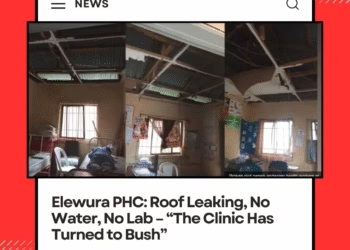Fellow Nurses Africa | Lagos, Nigeria | 29 August, 2025

An investigative report exposing how a Sh104 billion digital healthcare revolution became a nightmare for patients and healthcare providers
Kenya’s Healthcare System in Freefall: The SHA Crisis That’s Killing a Nation’s Promise of Universal Health Coverage
The Death of a Century-Old Promise
In Mumias, Western Kenya, the gates of St. Mary’s Hospital stand eerily closed. For 117 years, this medical institution served as a beacon of hope for thousands of families across Kakamega County. Today, it represents the catastrophic failure of Kenya’s ambitious healthcare transformation, a cautionary tale of how digital promises can become analog nightmares.
The hospital’s closure on July 1, 2025, wasn’t just the end of a medical facility. It was the death certificate of Kenya’s Universal Health Coverage dream, signed by bureaucratic incompetence and systemic corruption.
The Sh24 Billion Black Hole
What started as Kenya’s most ambitious healthcare digitization project, the Social Health Authority (SHA) has morphed into one of the country’s most expensive failures. The digital superhighway system, which cost the taxpayer Sh104 billion, crumpled, exposing the claims process to manipulation, with about Sh24 billion feared lost in the system’s collapse.
The numbers tell a stark story:
- Sh180 million: Unpaid claims that forced St. Mary’s Hospital to close
- 45 health facilities: Recently suspended for fraud and irregularities
- 158 facilities in Nairobi: Shut down for employing unlicensed staff
- Millions of patients: Left without accessible healthcare
A System Built on Ghosts
Perhaps the most damning revelation comes from political leader Edwin Sifuna’s exposé. Speaking during a church service, Sifuna said corruption within SHA had reached alarming levels, citing billions claimed to be siphoned to ghost facilities while legitimate hospitals like St. Mary’s struggle to survive.
This isn’t just financial mismanagement, it is institutional murder of healthcare access.
The Human Cost: Voices from the Wreckage
“This is the most painful story. I was born here,” wrote one Facebook user about St. Mary’s closure.
“So sad. This hospital has been such a savior for us in that region!” lamented another.
These aren’t just statistical casualties, they are communities losing their healthcare lifelines while bureaucrats count digital coins that may never have existed.
The Fraud Factory: How SHA Became a Criminal Enterprise
Recent investigations have uncovered a sophisticated fraud network within SHA operations. The crackdown, published in the Kenya Gazette on August 26, 2025, follows weeks of investigations into suspicious billing practices, including duplicated maternity claims, fabricated clinical records, and unqualified staff approvals.
The pattern is clear:
- Ghost hospitals receive payments for non-existent services
- Real hospitals providing actual care go unpaid
- Patients suffer while administrators profit
- The system collapses under the weight of its own corruption
Political Theater While Patients Die
While hospitals close and patients suffer, Kenya’s political class engages in blame games. COTU Secretary-General Francis Atwoli said SHA’s work remains constrained because of lack of independence, while MPs like Peter Salasya demand resignations and threaten impeachment proceedings.
But political posturing cannot revive closed hospitals or restore public trust in a system that has become synonymous with corruption.
The International Implications
Kenya’s SHA disaster offers crucial lessons for developing nations attempting healthcare digitization:
The Technology Trap
Throwing money at digital solutions without addressing fundamental governance issues creates expensive failures, not healthcare improvements.
The Corruption Accelerator
Digital systems, without proper oversight, can actually accelerate corruption by making fraudulent transactions easier and less detectable.
The Trust Deficit
Once public confidence is lost, even legitimate healthcare initiatives become suspect, creating a vicious cycle of system failure.
What Went Wrong: A Forensic Analysis
- Over-reliance on Technology: The belief that a Sh104 billion digital system could solve systemic healthcare problems
- Inadequate Oversight: Lack of real-time monitoring allowed fraud to flourish
- Political Interference: The system became a tool for patronage rather than healthcare delivery
- Rushed Implementation: The transition from NHIF to SHA was poorly planned and executed
The Path Forward: Can Kenya’s Healthcare Be Saved?
Recovery requires acknowledging that healthcare transformation is fundamentally about governance, not technology:
Immediate Actions Needed:
- Forensic audit of all SHA transactions
- Criminal prosecution of fraud perpetrators
- Emergency funding for struggling hospitals
- Transparent reporting of all healthcare expenditures
Long-term Reforms:
- Decentralized healthcare governance
- Community-based monitoring systems
- Public-private partnerships with accountability mechanisms
- Gradual, monitored digital integration
Conclusion: A Nation’s Health Held Hostage
The closure of St. Mary’s Hospital after 117 years of service represents more than institutional failure—it’s a betrayal of Kenya’s social contract with its citizens. When a government promises Universal Health Coverage and delivers universal healthcare crisis instead, it undermines the very foundation of public trust.
For months, the Social Health Authority (SHA) has failed to pay hospitals for services already rendered, some claims dating back to the defunct NHIF era. This isn’t just administrative incompetence; it’s institutional negligence that costs lives.
As Kenya grapples with this healthcare catastrophe, the international community must ask: How many more St. Mary’s Hospitals must close before accountability becomes more important than political survival?
The answers to this question will determine whether Kenya’s healthcare system can be resurrected, or whether it will remain a cautionary tale of digital promises and analog failures.
This investigation is based on multiple sources and ongoing developments in Kenya’s healthcare crisis. The situation continues to evolve as more facilities face closure and more revelations about SHA’s failures emerge.
Fellow Nurses Africa is the independent voice of African nurses. We educate, inform and support the nursing profession.










